This spiritual journey through northern India celebrates the region’s Tibetan Buddhist heritage. Over 13 days, you’ll visit a dozen historic monasteries in the exotic states of West Bengal and Sikkim, mountainous regions famous for their hillside towns and sweeping Himalayan views. You’ll also spend time in Darjeeling, where you’ll wander through the fields of family-run tea plantations and sample brews made from what many consider to be the world’s finest tea leaves.
Highlights
- Discover the highlights of New Delhi, including the India Gate.
- Tea tastings and pagoda tours in Darjeeling
- Visit some of the oldest Tibetan and Buddhist monasteries in India.
- The different sects of Tibetan Buddhism are exhibited in northern India.
Detailed Itinerary
Day 1: Arrive New Delhi, Walk in Lodhi Garden

Welcome to India! This adventure takes you to the spectacular north of this gigantic country. It begins in New Delhi, the capital and largest city of India. This metropolis is full of energy and is home to many historical sites known for their dazzling Indo-Islamic architecture.
Our driver & guide will pick you up from the hotel and take you to your hotel. After settling in, you can stretch your legs after the long flight with a guided walk in Lodhi Garden, one of the city’s most popular parks. This 36-hectare green lung is home to the 15th-century royal tomb of Sultan Mohammed Shah, as well as smaller buildings and beautiful verandas dating from the late Mughal period (17th-18th centuries).
After this relaxing stroll, join the locals for a cup of chai (sweet, strong, milky tea) at a teahouse located in the center of the gardens. Fun fact: Delhi’s iconic landmark, India Gate, is just a stone’s throw from Lodhi.
Day 2: Fly to Bagdogra & drive to Darjeeling, Optional Activities
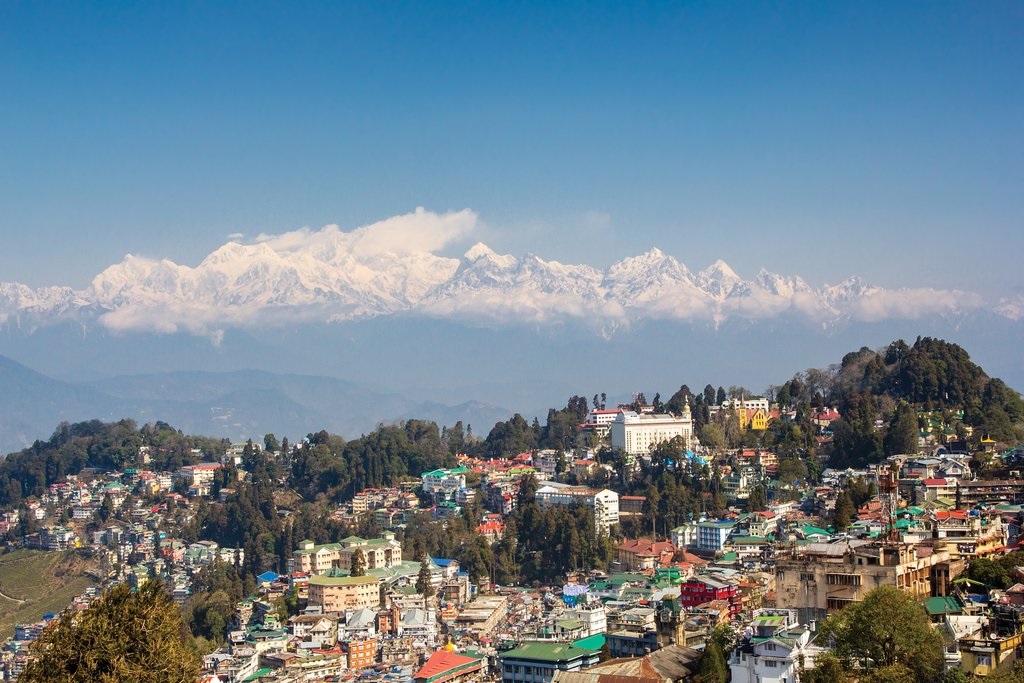
Early wake up ! This morning, you’ll return to the airport for a 2-hour flight to Bagdogra. This city lies at the foot of the lower Himalayas in the state of West Bengal. Bagdogra is one of the gateways to India’s famous Darjeeling region, known for its lush tea plantations set against the snow-capped peaks of the Himalayas. Upon arrival at the airport, you’ll meet a driver for a scenic 3-4 hour drive north to the town of Darjeeling, where your northern adventures begin.
One of the highlights of the drive is the Teesta River, whose emerald waters run alongside the road for much of the journey. The drive continues into the hills, offering panoramic views of lush green valleys and terraced tea gardens. You’ll also pass through charming hillside villages inhabited by diverse communities including the Gorkhas, Lepchas and Tibetan refugees. These villages are known for their vibrant prayer flags, monasteries and traditional homes, offering a glimpse into the region’s rich heritage.
As you enter Darjeeling, you’ll pass historic tea estates, many of which have opened their gates for tours. These estates are not only picturesque, they also produce some of the world’s finest tea varieties. The town was founded as a hill station by the British in 1835 and is full of colonial-era architecture, colourful markets and bustling streets lined with shops selling handicrafts, wool and local tea. After settling into your accommodation, you’ll have the rest of the day to browse these shops and markets.
Day 3: Darjeeling Sightseeing and Tea Tasting
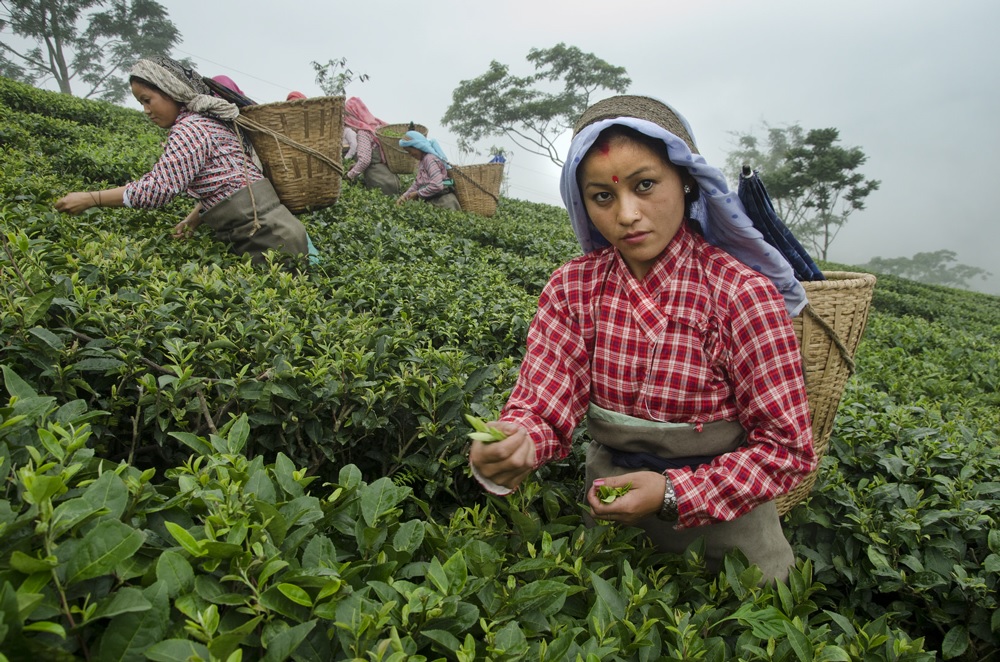
Today’s tour begins early, before dawn, with a drive to the sunrise spot at Tiger Hill. As the sun rises over the mountains, you’ll enjoy panoramic views of the Himalayas, including peaks like Kanchandzonga and Mount Everest, which come alive in the morning light. Then, on the way back down, you’ll visit Ghoom Monastery to see its large golden statue of Maitreya Buddha.
After breakfast at the hotel, the city tour continues with visits to the Himalayan Mountaineering Institute, the Zoological Park, Tenzing Rock and the Japanese Temple. You’ll also get to admire the views from Observatory Hill, which once housed Darjeeling’s oldest monastery (the building was moved in the late 19th century). (After a 15-minute climb, you’ll reach the top for a view and then spend some time browsing the local market.
Later in the afternoon, discover Darjeeling’s most famous export at a tea tasting. This two-hour experience takes place at a tea shop in town. You’ll wander through the shop’s hillside gardens and witness the production process, from harvesting to withering the leaves. You’ll also sample the different varieties of Darjeeling tea, known for their complex flavors, ranging from light and floral to fruity and robust.
Day 4: Peace Pagoda Visit and Tea Plantation Tour

Today, you will continue to explore the highlights of Darjeeling on a guided tour. Among the highlights is the Peace Pagoda, located about an hour by train outside the city. Situated on the slopes of Jalapahar Hill, the pagoda was founded by a Japanese Buddhist monk and inaugurated in 1992. It was designed as a monument to world peace and a sanctuary for people of all races and creeds who support this goal.
After the pagoda, you will visit a historic tea plantation and factory for a two-hour tour. The Makaibari Estate is located in the beautiful Kurseong Valley of Darjeeling and has been run by the same family for four generations. Here, you will learn about the tea production process from field to cup, and end your tour with a tea tasting. Later you will return to the city and your hotel for overnight stay.
Day 5: Darjeeling – Pelling, stop at monasteries and ruins

This morning, you will meet your driver and leave Darjeeling and West Bengal for a drive north through the Rangeet River Valley to Pelling. This small town is located in Sikkim, at the foot of Mount Khangchendzonga, in a region famous for its mountain biking destinations and historic monasteries.
The drive to Pelling takes about three hours and, along the way, you will stop at several monasteries to visit and admire the views. One of these is Pemayangste. Dating back to 1705, this monastery is one of the oldest in the state and offers excellent views of the Himalayas. Nearby are the Rabdentse Ruins, a capital of the Kingdom of Sikkim that was destroyed in the early 19th century. Today, these ruins are part of a popular Buddhist pilgrimage route.
Another stop is Namchi, a mountain town that is also home to beautiful monasteries, such as Sherdup Choeling. Here you can enjoy unparalleled views of the Khangchendzonga range and the Rangit Valley. After the stop, you continue to Pelling, where you check into your hotel. Pelling is also famous for its excellent rafting, and if you have time left in the day, you can brave the rapids on a white water rafting trip.
Day 6: Drive to Yuksom, visit Khecheopalri Lake and Dubdi Monastery

The journey continues this morning with a 2.5-hour drive from Pelling to the historic hill town of Yuksom. En route, you will stop at the flowing waters of Khecheopalri Lake, considered sacred by Buddhists and Hindus. Surrounded by forests, it is believed that even birds prevent a single leaf from falling into the water.
Continue to Dubdi Monastery (which translates to ‘the retreat’). Founded in 1701, it is one of the oldest monasteries in Sikkim. It takes an hour to climb the hill to the monastery through forests with views of the mountains. Birdwatchers will enjoy this walk as they will have the opportunity to spot colorful species like the Himalayan cutia, Tibetan canary, red-headed trogon, and many more.
Later, you will arrive at Yuksom, and after checking into your hotel, you can explore the highlights of the town. Norbugang Park is a must-see. This historic forested garden houses a stupa built after the coronation of the first Chogyal (monarch) of Sikkim in 1642.
Day 7: Transfer to Gangtok, Stop at Tashiding Monastery
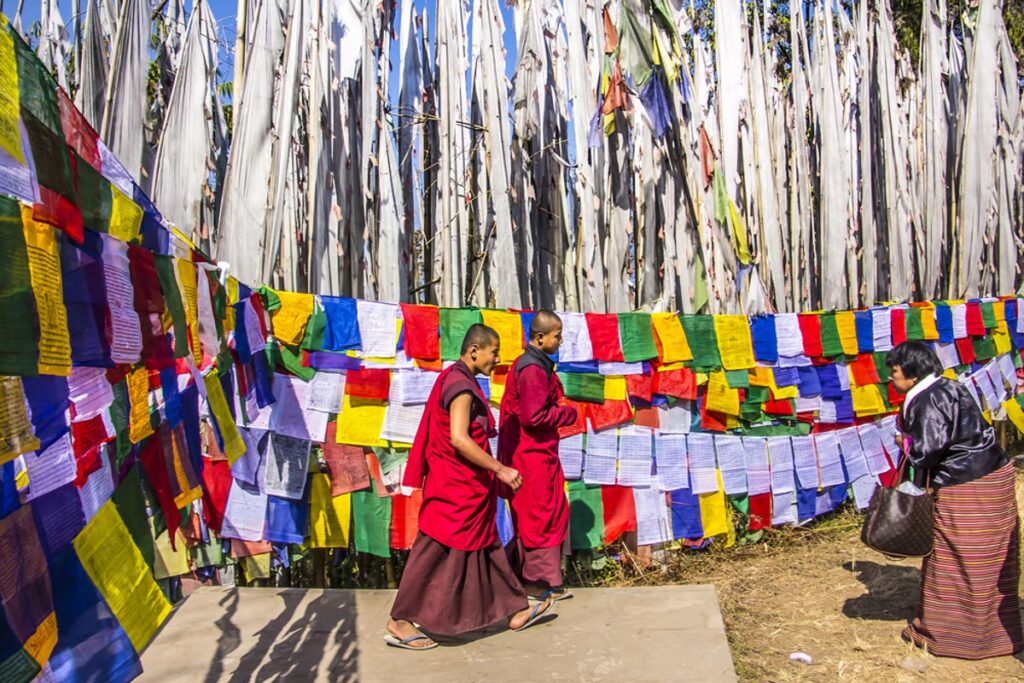
After breakfast, you will leave Yuksom for a five-hour drive east to Gangtok, the capital of the hill state of Sikkim. En route, you will visit Tashiding Monastery, which sits atop a heart-shaped hill, backed by the craggy peak of Mount Khangchendzonga. It is famous for its Thong-WaRang-Dol chorten (Buddhist shrine), which literally translates to “saviors on sight” and is believed to purify the souls of those who gaze upon it. Later, you will continue to Gangtok and check into the hotel. You can then spend the evening relaxing.
Day 8: Gangtok Sightseeing

Take a break on the road and take the day to see the highlights of Gangtok on a guided tour. The tour begins with Enchey Monastery, also known as the Solitary Temple. It is an important seat of the Nyingma order, the oldest of the four major schools of Tibetan Buddhism. When it was built over 200 years ago, no other construction was allowed nearby. The site was blessed by Lama Druptob Karpo, a tantric master known for his powers of flight, and every year a chaam (masked religious dance) is performed in grand style for over two days.
Continue to the city’s sightseeing, colorful murals, and the Namgyal Institute, a Tibetan museum. The main hall houses a priceless collection of Tibetan/Buddhist iconography and artifacts, ranging from thangkas (cloth paintings), coins and amulets to tantric skull-cap bowls and trumpets made from human thigh bones. Buddhist statuary includes an eight-armed bronze image of the goddess of victory Namgyalama, who appears to be texting on an invisible phone.
On the way back to Gangtok, stop at the Handloom and Handicrafts Center to see traditional handicrafts, hand-woven carpets and more. If there is time left in the day and you are in the mood for a thrill, you can opt for a paragliding adventure for a bird’s eye view of Gangtok and the surrounding mountains.
Day 9: Excursion to Phodong and Labrang Monasteries
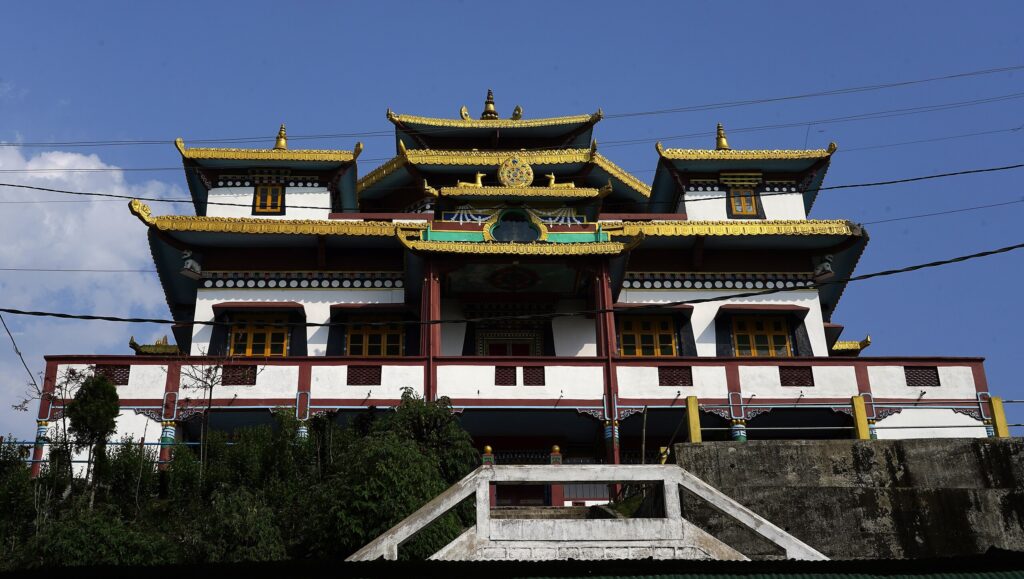
Spend the day visiting some of the major monasteries around Gangtok. The first is the 18th-century Phodong, one of the six most important Buddhist monasteries in Sikkim. It is affiliated with the Kargyupa (Karmapa) sect of Buddhism and is located at an altitude of 1,372 m. The next stop is the nearby Labrang Monastery. Founded in 1826, this monastery has a large expanse of land ideal for mass gatherings. At the end of the day, you will return to Gangtok and your hotel.
Day 10: Transfer to Kalimpong, stop at Rumtek Monastery

This morning, you will leave Gangtok for a two-hour drive south towards West Bengal and the hill town of Kalimpong. You will stop en route to visit Rumtek. Rumtek, one of the most impressive monasteries on the circuit, dates back to the mid-18th century and is the seat of the Karmapa Lama, the third highest-ranking monk in Tibetan Buddhism. The beautiful structure houses a golden stupa that contains statues and paintings dating back to the 16th Karmapa, as well as religious artifacts and some beautiful religious scriptures.
Later, you will arrive in Kalimpong. This picturesque hill station was originally part of the Sikkimese and then Bhutanese kingdoms and was annexed by the British in the 19th century. After checking into your hotel, you will visit one of the icons of the British colonial period: Crockety House.
This bungalow was originally built in the style of English cottages by wool traders in the 18th century. In the mid-19th century, it became the residence of Helena Roerich, a famous Russian theosophist, writer and philosopher. Today, this monument is a place of pilgrimage for those interested in theosophy and the Roerich family’s contributions to spiritual and philosophical thought.
Day 11: Kalimpong Sightseeing
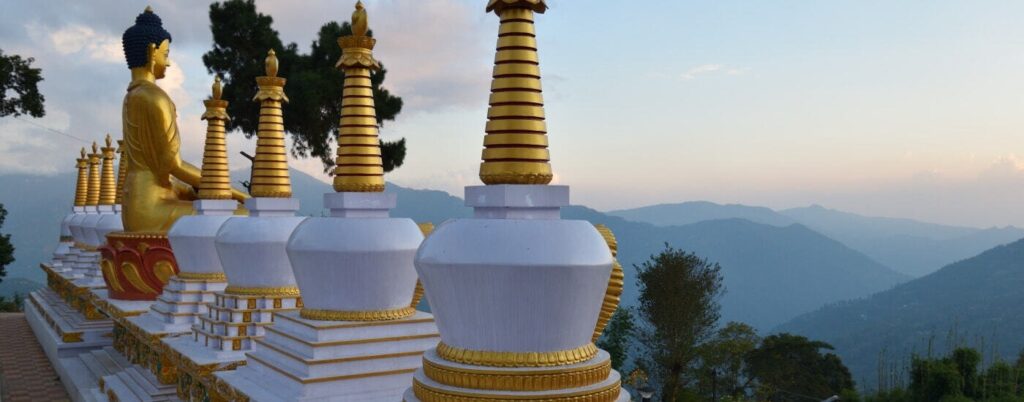
Discover the highlights of Kalimpong as you meet your local guide for a full-day tour. The excursion begins with the venerable Tharpa Choling Gompa. Founded in 1937, this hilltop monastery belongs to the Yellow Hat (Gelugpa) sect of Tibetan Buddhism and is the repository of ancient scriptures and documents.
The next monastery is Thongsa Gumpa, the oldest monastery in Kalimpong. Of Bhutanese origin, it was built in 1692, although the original structure was destroyed during the inter-clan wars that preceded the arrival of the British. The tour ends at the MacFarlane Memorial Church, an imposing 19th-century Gothic building that overlooks Kalimpong. The evening is spent enjoying dinner in town and exploring the local markets.
Day 12: Transfer to Bagdogra, Fly to Delhi
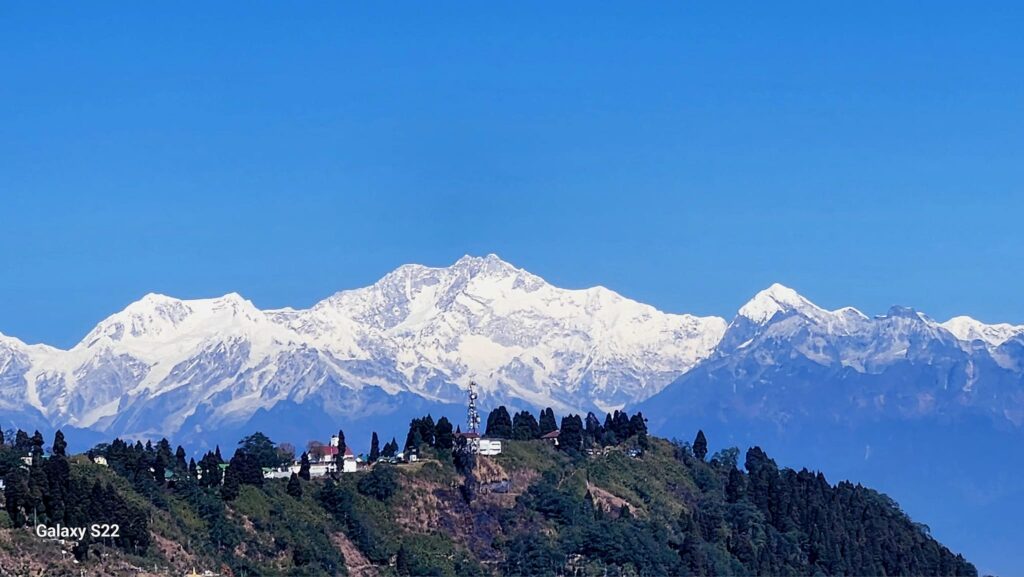
After an early breakfast and meet your driver for the 3.5-hour drive south to Bagdogra. This is a scenic drive, with the last views of the lush green valleys surrounded by the foothills of the Himalayas. At Bagdogra airport, you will take a two-hour flight to New Delhi. One of our staff will meet you at the terminal to take you to your hotel, after which you will have one last evening to enjoy Delhi.
Day 13: Depart Onward Destination

You’ve explored some of the most beautiful and mystical regions of India, now it’s time to pack up your souvenirs and head home. Sip chai over a final leisurely breakfast before heading to the airport, where your departure flight awaits. Enjoy your trip!
Check out time 11H00
